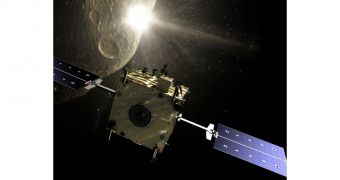The European-lead Asteroid Impact and Deflection Assessment mission, or AIDA, is moving ahead as planned and now has a target.
The scientists are currently planning to send their two spacecraft towards the Didymos asteroid to test whether they can alter the trajectory of a large asteroid by crashing into it.
Two spacecraft, one built by ESA, the other by US scientists, will launch in 2019 and will meet up with the asteroid three years later. Didymos is actually part of a binary asteroid system.
Didymos itself is 800 meters (2,600 feet) across while its companion is 150 meters (490 feet). The asteroid will be 11 million kilometers (6.8 million miles) from Earth at its closest in 2022.
The US craft, dubbed DART for Double Asteroid Redirection Test, will crash into the smaller asteroid while the larger Asteroid Impact Monitor, or AIM, will watch.
The hope is that the impact will be powerful enough to send the small asteroid slightly off course.
Scientists will be keeping a close eye on what happens hoping to gather valuable data for a potential future mission to deflect an asteroid that is actually threatening Earth.

 14 DAY TRIAL //
14 DAY TRIAL //